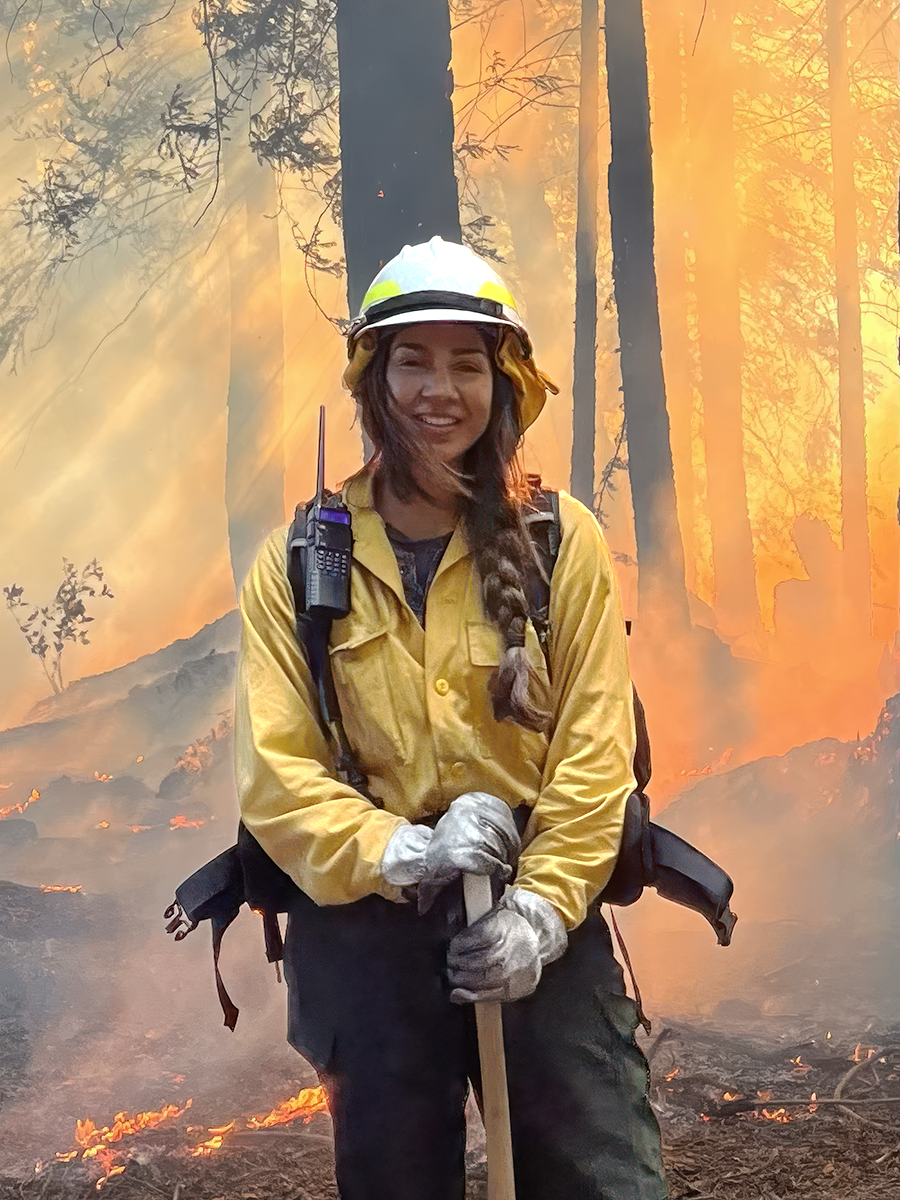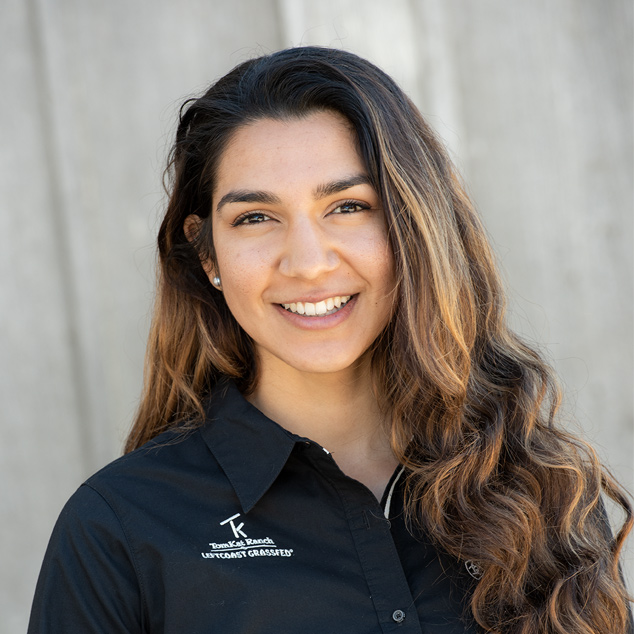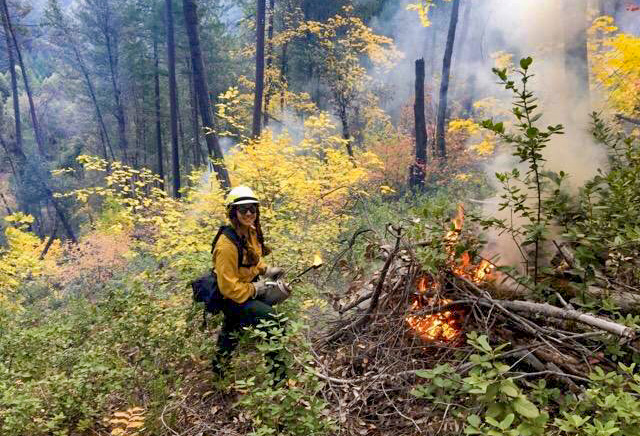I recently caught up with one of our past apprentices, Alex Michel, who was an apprentice in our Land and Livestock program from September 2020-December 2021
Where Are They Now – Alex Michel
09/23/2024
By: Kathy Webster and Alex Michel

I recently caught up with one of our past apprentices, Alex Michel, who was an apprentice in our Land and Livestock program from September 2020-December 2021. I always enjoy staying in touch with our apprentices, as they all go on to do amazing things, and not just in agriculture.
Alex is the Prescribed Burn Coordinator for Central Coast PBA that serves San Benito, Santa Cruz, and Monterey counties. The Central Coast Prescribed Burn Association is a diverse network of ranchers, researchers, Indigenous groups, foresters, fire professionals, homeowners, land trusts, and other land-focused organizations.
I recently asked Alex about her time at TomKat Ranch.
How did you find out about TomKat Ranch?
Alex: I was at Cal Poly and I was doing a Land & Livestock internship at Swanton Pacific Ranch (Cal Poly’s ranch in Davenport, CA) and we did a day swap with TomKat Ranch where interns from Swanton Pacific Ranch went to learn from TomKat Ranch. And then TomKat Ranch’s interns came down to Swanton Pacific Ranch a few weeks later.
How did you get involved in agriculture/ranching in the first place?
Alex: Well, I grew up in Downey (LA area); I didn’t grow up on a ranch or farm. At Cal Poly, I was studying Landscape Architecture and my roommates were all studying Animal Science. They were taking classes at Swanton Pacific Ranch and would come back and talk about building fences, putting in water lines, and I thought it would be cool to learn more about how larger-scale landscapes functioned, so I signed up for the class. The livestock manager at the time was Gordon Classenn and he took me under his wing. I was hooked and took the in-field course several times to build on what I was learning in the studio. I strongly believe that Cal Poly should incorporate hands-on land management into the curriculum for the Landscape Architecture program.

What was your favorite memory at TomKat?
Alex: There are so many! Shortly after starting the apprentice program, the CZU Lightening Complex struck the area (August 2020). We were told to evacuate Pescadero and the ranch, and we ended up staying in SF. The experience of sneaking back, using back roads to get over to TomKat Ranch’s land leases to take care of the cattle and sometimes camping out with them was kind of a thrill! The people of Pescadero really came together during that time. Providing each other with food and places to sleep, watching each other’s animals, and trailering livestock, was inspiring.
Other great memories at TomKat came from the never-ending days of fencing. I remember my coworkers and I getting a ranch version of tennis elbow from pounding fiberglass posts into the ground, especially when the ground was hard in the summer. There were days that fencing frustrated me to no end. When the tall grass and the Pescadero marine layer soaked my boots to my waist in the first and coldest hour of the day; days when I’d spend hours untangling 1,000 miles of poly wire from the poison oaky brush and putting it all up again, just to wake up the next morning and see that the cows had pranced their way through a hole in the brush somewhere that I didn’t see. But I will say, those days were outnumbered by the days when I wanted nothing more than to spend hours bopping around the hills, spinning out fence line in the sun while listening to podcasts (I still don’t know if that was technically allowed), and setting up pasture moves for several days ahead. Seeing the tight, even grazing and the subsequent vegetative response that came from holding cattle in those sections we created was so satisfying. In a way, it’s kind of like seeing the response after a prescribed burn you worked hard to prep and keep within your control lines.
Of course, many great memories from my time at TomKat came from celebrating with the other apprentices after an especially long but good week of working together.
Who was the most influential person during your time at TomKat Ranch?
Alex: Everyone played a big part in my experience. Mark gave us the space to learn new things, fail, and try again and again until the desired outcome became consistent. This was true for many things, like fixing (sometimes jerry-rigging) water systems to get water to the cattle, working on the ranch trucks and ATVs, tinkering with the drill settings on a tractor to sow the right amount of seed for the acreage we wanted to cover (a.k.a. “mathing it out”), and so much more. It was the process of learning to work through technical issues step by step that I still try to practice with everything I do today—sometimes, successfully!

Suzane [Rowland], Bill [Milliot], Susan [Hadacek] and you all helped ground us (apprentices) day to day, always encouraging us and giving us positive feedback. Everyone was always working on a cool project related to regenerative agriculture and food sovereignty. As I started looking forward to my career past my TomKat apprenticeship, Wendy became a listening ear and provided wisdom on our walks together.
Where are you and what are you doing now?
Alex: I’m a Prescribed Burn Coordinator working with the Central Coast Prescribed Burn Association. I help conduct landowner site visits, write burn plans, organize and prep the burns, and train people during burns. We also put on a slew of fire-related trainings and workshops, some offering NWCG certification.
I work with a conglomerate of characters in Santa Cruz, San Benito, and Monterey Counties. Since we open it to the community to come learn and participate in the prescribed burns, I get to meet so many different people. A couple years ago, we put on a burn and I met a resident from Last Chance in the Davenport (California) area who came out. He was there wanting to learn and get comfortable with prescribed fire after his home burned in the CZU Complex.
Coming from a Mexican household in the city, where working in an office rather than on the land was the picture of success, I’d love to see younger inner-city generations get out on the land and get connected. They need to know that this land is also theirs and that there is joy and there are viable career paths in stewarding it—whether it be with cattle, fire, or another tool.
How did your TomKat experience shape where you are and what you are doing now?
Alex: If it hadn’t been for Mark not being able to attend a PBA Basic Wildland Firefighter training he had signed up for (letting me take his place), I would never have even considered prescribed fire being a career option. I had a job offer from a landscape architecture firm in Bozeman, Montana, which I found through a ranch magazine in the staff kitchen at TomKat one day. Taking the PBA fire course got my foot in the door and I met my current boss, Jared Childress, Central Coast PBA Program Manager.